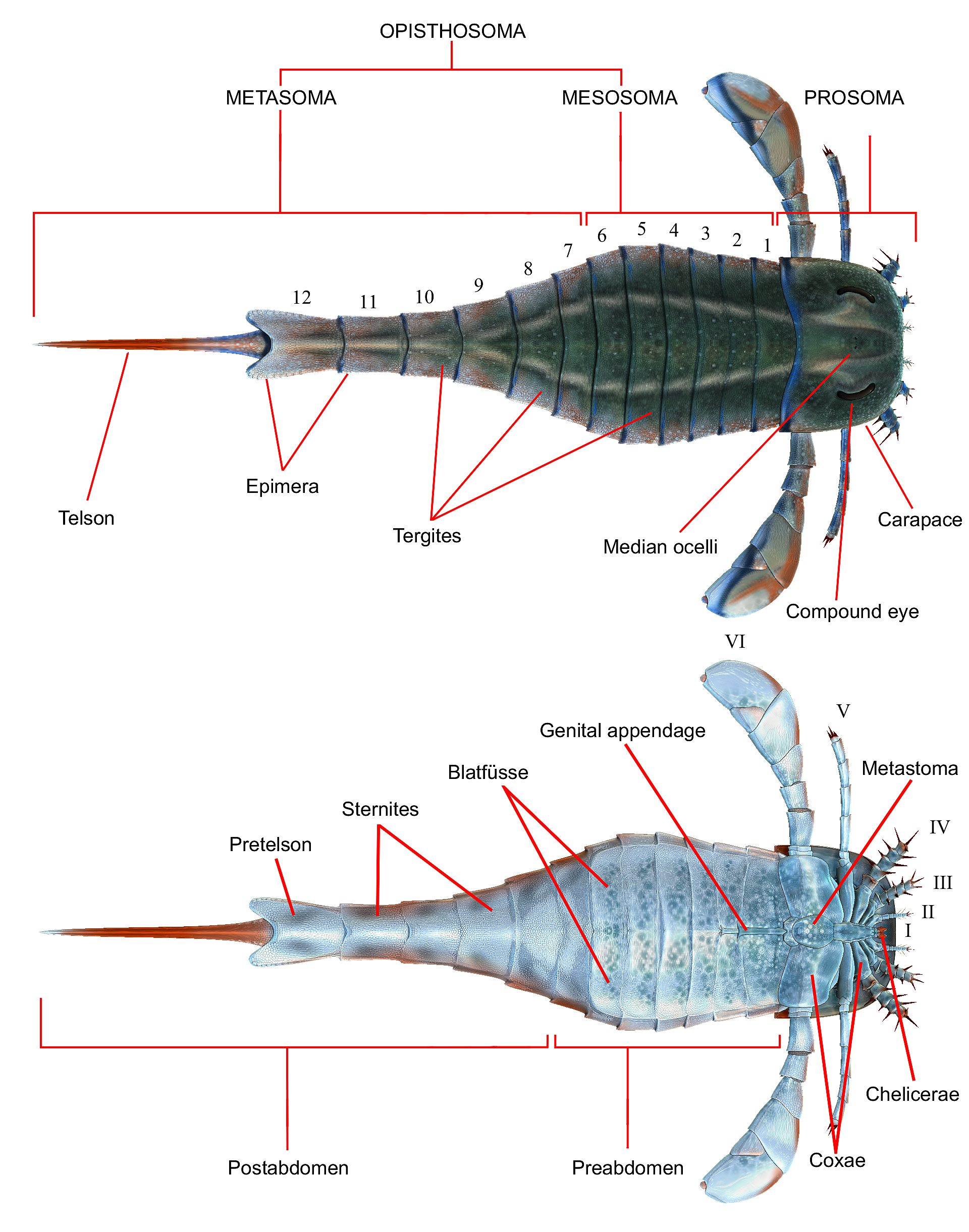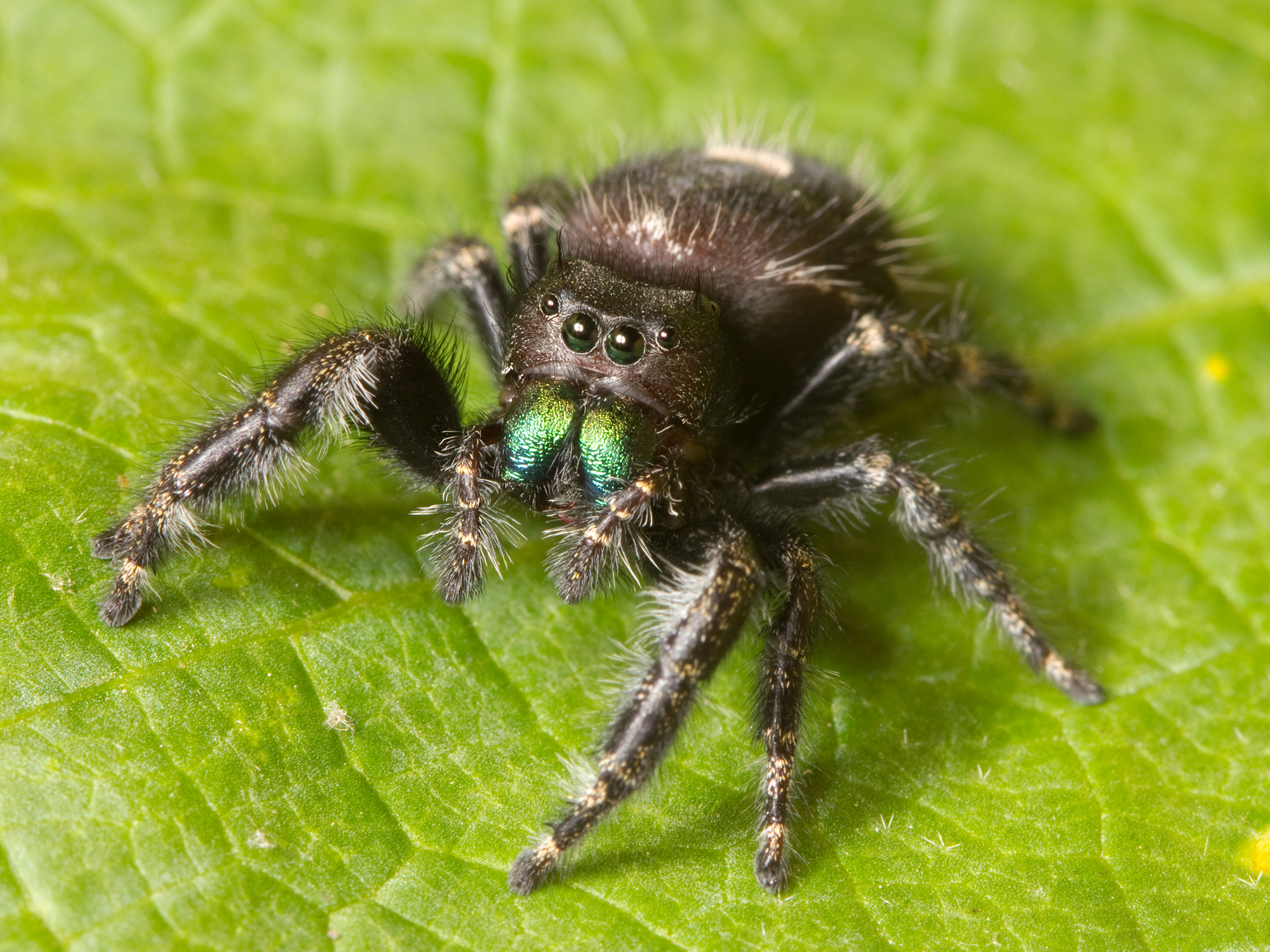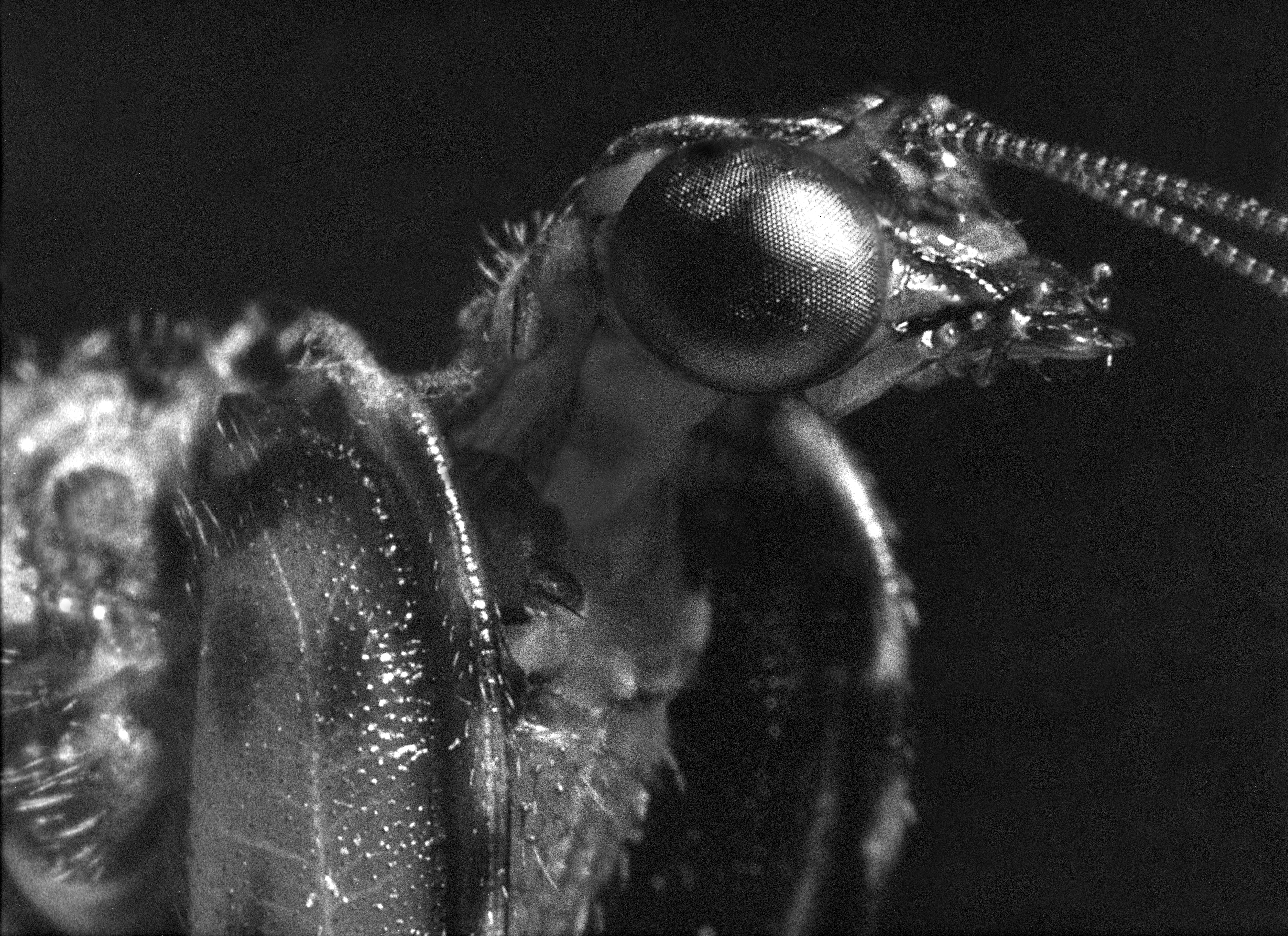|
Acutiramus
''Acutiramus'' is a genus of giant predatory eurypterid, an extinct group of aquatic arthropods. Fossils of ''Acutiramus'' have been discovered in deposits of Late Silurian to Early Devonian age. Eight species have been described, five from North America (including ''A. cummingsi'', the type species) and two from the Czech Republic (with one of them potentially found in Australia as well). The generic name derives from Latin ''acuto'' ("acute" or "sharp") and Latin ''ramus'' ("branch"), referring to the acute angle of the final tooth of the claws relative to the rest of the claw. ''Acutiramus'' is classified as part of the eurypterid family Pterygotidae, a family differentiated from other eurypterids by their flattened telsons (the most posterior segment of the body) and their modified chelicerae (frontal appendages), ending in well-developed chelae (claws). Many pterygotid eurypterids, such as ''Jaekelopterus'' and ''Pterygotus'', grew to gigantic proportions. ''Acutiramus'' wa ... [...More Info...] [...Related Items...] OR: [Wikipedia] [Google] [Baidu] |
Pterygotidae
Pterygotidae (the name deriving from the type genus ''Pterygotus'', meaning "winged one") is a family of eurypterids, an extinct group of aquatic arthropods. They were members of the superfamily Pterygotioidea. Pterygotids were the largest known arthropods to have ever lived with some members of the family, such as ''Jaekelopterus'' and ''Acutiramus'', exceeding 2 metres (6.6 ft) in length. Their fossilized remains have been recovered in deposits ranging in age from 428 to 372 million years old (Late Silurian to Late Devonian). One of the most successful groups of eurypterids, the pterygotids were the only eurypterid family to achieve a truly cosmopolitan distribution, worldwide distribution. Several evolutionary innovations made the pterygotids unique among the eurypterids, with large and flattened telsons (the posteriormost division of the body) likely used as rudders to provide additional agility and enlarged chelicerae (frontal appendages) with claws. These claws were ro ... [...More Info...] [...Related Items...] OR: [Wikipedia] [Google] [Baidu] |
Pterygotus
''Pterygotus'' is an extinct genus of giant predatory eurypterid, a group of extinct aquatic arthropods. Fossils of ''Pterygotus'' have been discovered in deposits ranging in age from Middle Silurian to Late Devonian, and have been referred to several different species. Fossils have been recovered from four continents; Australia (continent), Australia, Europe, North America and South America, which indicates that ''Pterygotus'' might have had a nearly Cosmopolitan distribution, cosmopolitan (worldwide) distribution. The type species, ''P. anglicus'', was described by Swiss naturalist Louis Agassiz in 1839, who gave it the name ''Pterygotus'', meaning "winged one". Agassiz mistakenly believed the remains were of a giant fish; he would only realize the mistake five years later in 1844. ''Pterygotus'' was among the largest eurypterids. Isolated fossil remains of a large Chelicerae, chelicera (frontal appendage) suggests that the largest known species, ''P. grandidentatus'', reached ... [...More Info...] [...Related Items...] OR: [Wikipedia] [Google] [Baidu] |
Jaekelopterus
''Jaekelopterus'' is a genus of predatory eurypterid Eurypterids, often informally called sea scorpions, are a group of extinct marine arthropods that form the Order (biology), order Eurypterida. The earliest known eurypterids date to the Darriwilian stage of the Ordovician period, 467.3 Myr, mil ..., a group of extinct aquatic arthropods. Fossils of ''Jaekelopterus'' have been discovered in deposits of Early Devonian age, from the Pragian and Emsian stages. There are two known species: the type species ''J. rhenaniae'' from Brackish water, brackish to fresh water strata in the Rhineland, and ''J. howelli'' from Estuary, estuarine strata in Wyoming. The generic name combines the name of German paleontologist Otto Jaekel, who described the type species, and the Ancient Greek, Greek word () meaning 'wing'. Based on the isolated fossil remains of a large Chelicerae, chelicera (claw) from the Klerf Formation of Germany, ''J. rhenaniae'' has been estimated to have reached ... [...More Info...] [...Related Items...] OR: [Wikipedia] [Google] [Baidu] |
Jaekelopterus Rhenaniae
''Jaekelopterus'' is a genus of predatory eurypterid, a group of extinct aquatic arthropods. Fossils of ''Jaekelopterus'' have been discovered in deposits of Early Devonian age, from the Pragian and Emsian stages. There are two known species: the type species ''J. rhenaniae'' from brackish to fresh water strata in the Rhineland, and ''J. howelli'' from estuarine strata in Wyoming. The generic name combines the name of German paleontologist Otto Jaekel, who described the type species, and the Greek word () meaning 'wing'. Based on the isolated fossil remains of a large chelicera (claw) from the Klerf Formation of Germany, ''J. rhenaniae'' has been estimated to have reached a size of around 2.3–2.6 metres (7.5–8.5 ft), making it the largest arthropod ever discovered, surpassing other large arthropods such as fellow eurypterids ''Acutiramus'' and ''Pterygotus''; the millipede ''Arthropleura''. ''J. howelli'' was much smaller, reaching 80 centimetres (2.6 ft) in ... [...More Info...] [...Related Items...] OR: [Wikipedia] [Google] [Baidu] |
Eurypterid
Eurypterids, often informally called sea scorpions, are a group of extinct marine arthropods that form the Order (biology), order Eurypterida. The earliest known eurypterids date to the Darriwilian stage of the Ordovician period, 467.3 Myr, million years ago. The group is likely to have appeared first either during the Early Ordovician or Late Cambrian period. With approximately 250 species, the Eurypterida is the most diverse Paleozoic Chelicerata, chelicerate order. Following their appearance during the Ordovician, eurypterids became major components of marine faunas during the Silurian, from which the majority of eurypterid species have been described. The Silurian genus ''Eurypterus'' accounts for more than 90% of all known eurypterid specimens. Though the group continued to diversify during the subsequent Devonian period, the eurypterids were heavily affected by the Late Devonian extinction event. They declined in numbers and diversity until becoming extinct during the Permi ... [...More Info...] [...Related Items...] OR: [Wikipedia] [Google] [Baidu] |
Chelicerae
The chelicerae () are the arthropod mouthparts, mouthparts of the subphylum Chelicerata, an arthropod group that includes arachnids, horseshoe crabs, and sea spiders. Commonly referred to as "jaws", chelicerae may be shaped as either articulated fangs, or as a type of pincer_(biology), pincers. Some chelicerae, such as those found on nearly all spiders, are hollow and contain (or are connected to) venom glands, used to inject venom into prey or a perceived threat. Both pseudoscorpions and Opiliones , harvestmen have additional structures on their chelicerae that are used for grooming (papillae in pseudoscorpions, cheliceral teeth in Opiliones). In ''Paratrechalea'', males and females have shown to have a chelicerae dimorphism, because the chelicerae is used as a mating signal for females. Types Chelicerae can be divided into three kinds: jackknife chelicerae, scissor chelicerae, and three-segmented wikt:chelate, chelate chelicerae. Jackknife chelicerae The jackknife chelicer ... [...More Info...] [...Related Items...] OR: [Wikipedia] [Google] [Baidu] |
Arthropod
Arthropods ( ) are invertebrates in the phylum Arthropoda. They possess an arthropod exoskeleton, exoskeleton with a cuticle made of chitin, often Mineralization (biology), mineralised with calcium carbonate, a body with differentiated (Metamerism (biology), metameric) Segmentation (biology), segments, and paired jointed appendages. In order to keep growing, they must go through stages of moulting, a process by which they shed their exoskeleton to reveal a new one. They form an extremely diverse group of up to ten million species. Haemolymph is the analogue of blood for most arthropods. An arthropod has an open circulatory system, with a body cavity called a haemocoel through which haemolymph circulates to the interior Organ (anatomy), organs. Like their exteriors, the internal organs of arthropods are generally built of repeated segments. They have ladder-like nervous systems, with paired Anatomical terms of location#Dorsal and ventral, ventral Ventral nerve cord, nerve cord ... [...More Info...] [...Related Items...] OR: [Wikipedia] [Google] [Baidu] |
Chela (organ)
A chela ()also called a claw, nipper, or pinceris a pincer-shaped organ at the end of certain limbs of some arthropods. The name comes from Ancient Greek , through Neo-Latin '. The plural form is chelae. Legs bearing a chela are called chelipeds. Another name is ''claw'' because most chelae are curved and have a sharp point like a claw. Chelae can be present at the tips of arthropod legs as well as their pedipalps. Chelae are distinct from spider chelicerae in that they do not contain venomous glands and cannot distribute venom. Uses Chelae have a wide variety of uses, but most commonly they are used for handling their prey and for defense. These uses are often reflected in the morphology of the chelae. For instance, some species, such as the members of the families Ocypodidae and Alpheidae show asymmetry between their paired claws. Possessing one enlarged chela used for defensive and courtship purposes and a smaller chela for shearing and feeding. For some species, this asym ... [...More Info...] [...Related Items...] OR: [Wikipedia] [Google] [Baidu] |
Biology Letters
''Biology Letters'' is a peer-reviewed scientific journal published by the Royal Society, established in 2005. It focuses on the rapid publication of short research articles, reviews, and opinion pieces across the biological sciences. The editor-in-chief is David Beerling FRS (University of Sheffield). Contents As well as conventional short research articles, the journal has recently published ''Special Features'' and ''Mini Series''. Special Features are collections of up to 20 articles on a specific theme and published across multiple issues. Mini Series include up to six articles that are published in one issue. History The journal was split off from the '' Proceedings of the Royal Society B: Biological Sciences'' in 2005 after having been published as a supplement. Originally it was published quarterly, then bimonthly, and since 2013 it has been published monthly. Printing ceased at the start of 2020. Abstracting and indexing The journal is abstracted and indexed in: Accord ... [...More Info...] [...Related Items...] OR: [Wikipedia] [Google] [Baidu] |
The Eurypterida Of New York/Volume 1/Pterygotidae
''The'' is a grammatical article in English, denoting nouns that are already or about to be mentioned, under discussion, implied or otherwise presumed familiar to listeners, readers, or speakers. It is the definite article in English. ''The'' is the most frequently used word in the English language; studies and analyses of texts have found it to account for seven percent of all printed English-language words. It is derived from gendered articles in Old English which combined in Middle English and now has a single form used with nouns of any gender. The word can be used with both singular and plural nouns, and with a noun that starts with any letter. This is different from many other languages, which have different forms of the definite article for different genders or numbers. Pronunciation In most dialects, "the" is pronounced as (with the voiced dental fricative followed by a schwa) when followed by a consonant sound, and as (homophone of the archaic pronoun ''thee'' ... [...More Info...] [...Related Items...] OR: [Wikipedia] [Google] [Baidu] |
Compound Eyes
A compound eye is a visual organ found in arthropods such as insects and crustaceans. It may consist of thousands of ommatidia, which are tiny independent photoreception units that consist of a cornea, lens, and photoreceptor cells which distinguish brightness and color. The image perceived by this arthropod eye is a combination of inputs from the numerous ommatidia, which are oriented to point in slightly different directions. Compared with single-aperture eyes, compound eyes have poor image resolution; however, they possess a very large view angle and the ability to detect fast movement and, in some cases, the polarization of light. Because a compound eye is made up of a collection of ommatidia, each with its own lens, light will enter each ommatidium instead of using a single entrance point. The individual light receptors behind each lens are then turned on and off due to a series of changes in the light intensity during movement or when an object is moving, creating a flic ... [...More Info...] [...Related Items...] OR: [Wikipedia] [Google] [Baidu] |
Prosoma
The cephalothorax, also called prosoma in some groups, is a tagma of various arthropods, comprising the head and the thorax fused together, as distinct from the abdomen behind. (The terms ''prosoma'' and ''opisthosoma'' are equivalent to ''cephalothorax'' and ''abdomen'' in some groups. The terms ''prosoma'' and ''opisthosoma'' may be preferred by some researchers in cases such as arachnids, where there is neither fossil nor embryonic evidence animals in this class have ever had separate heads and thoraxes, and where the ''opisthosoma'' contains organs atypical of a true ''abdomen'', such as a heart and respiratory organs.) The word ''cephalothorax'' is derived from the Greek words for head (, ') and thorax (, '). This fusion of the head and thorax is seen in chelicerates and crustaceans; in other groups, such as the Hexapoda (including insects), the head remains free of the thorax. In horseshoe crabs and many crustaceans, a hard shell called the carapace covers the cephalothorax. ... [...More Info...] [...Related Items...] OR: [Wikipedia] [Google] [Baidu] |









